First experimental transmission of wireless telegraph signals |
| Mahlom Loomis | Marconi and the Bristol Channel | Marconi and the transatlantic wireless | Epilogue and sources |
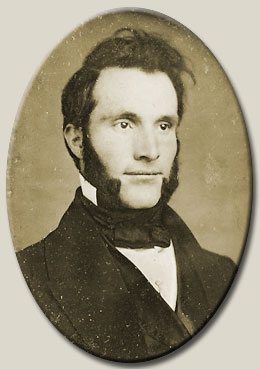 |
Mahlon Loomis was born July 21, 1826, in Oppenhiem New York. His parents Nathan, professor, and Waitie had already 3 children. Not a lot of details are available about Mahlon Loomis’ early life. His father was a founder of the AMERICAN EPHEMERIS and NATIONAL ALMANAC. In addition to this, his older brother George, was an inventor and holder of several patents himself. |
|
For several years Loomis spent time as a traveling dentist. He had taken, in 1854, a patent on a process to manufacture artificial kaolin teeth. Apparently Loomis became interested in electricity and radio in the mid-1850's. Some of his papers in the Library of Congress (Washington) record that he had worked out a theory of using the natural static electricity in the atmosphere to send signals, which he called “pulsations”, as early as 1858. In this same time period Loomis became interested in using the electrical charges obtainable from the upper atmosphere by means of kites carrying metal wires. This set him on a path of developing it as a system of wireless telegraphy for practical long distance communications. On February 20, 1864, Mahlon Loomis wrote in his journal: |
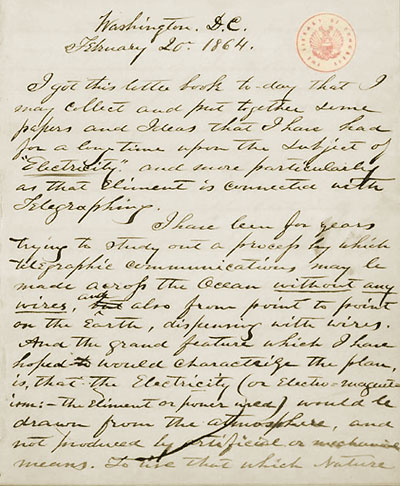 |
|
"..... I have been for years trying to study out a process by which telegraphic communications may be made across the ocean without any wires, and also from point to point on the earth, dispensing with wires....." (on the right : the whole text) Loomis’ claim to recognition as the inventor of radio is based on a series of experiments he did in the Blue Ridge Mountains area of Virginia in October, 1866, (eight years before the birth of Marconi). Among the witnesses to his experiment were Senator Samuel Pomeroy of Kansas and Congressman John A. Bingham of Ohio, both of whom became supporters of Loomis in his attempt to get Federal money to establish his discovery commercially. |
||
| The apparatus used by Mahlon Loomis was very simple, and could be duplicated today. | ||
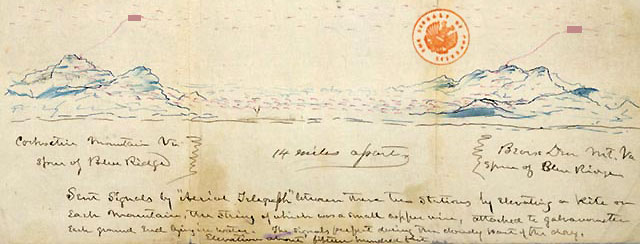 |
He established two stations on separate mountains 18 to 20 miles apart. At each station was a galvonometer, a kite, a 5-inch square grid of fine copper wire gauze, and 600' of copper wire to fly the kite with. The people conducting the experiment with Loomis had their watches set, and at predetermined intervals they grounded the wire which ran through the galvanometer to the transmitting kite, causing the other instrument on the opposite mountain to register. Loomis noted that the galvanometer of the “receiving” kite deviated at each time the “transmitting” kite was put at the mass. The experiment was repeated several times, causing the needles on the galvanometers to deflect every time the circuit was completed. |
| Drawing done by Mahlon Loomis, showing 14 miles between mountains. From Library of Congress Archives. |
The commercial possibilities of this discovery were immediately apparent. However Loomis understood quickly that it was necessary to develop a “detector” more sensitive than the galvanometer if he wanted to make transmissions on long distance without increase the surface of his grid and the size of the kite. Sometimes, there were problems with the communications system. It seemed that if one of the kites was at the wrong height, the system would not work. This led Loomis to believe that there were different areas in the atmosphere, and depending which area you were in, would control if the communication would work or not. on the right : The Transmitter/Receiver system developed by Loomis, diagram expound during meeting 2007 at Physics Museum, The University of Queensland |
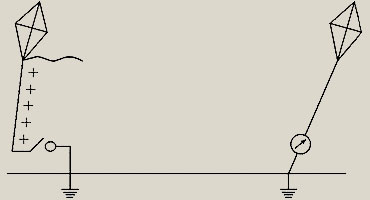 |
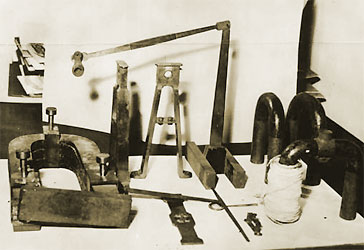 |
He did erect steel antennae, and continued to work to perfect his discovery, but finances were a continual problem. His experiments made a great fuss in the years 1870. His work became a matter of controversy in Congress when the Senator from Massachusetts, Charles Sumner, introduced a bill in 1869 to appropriate $50,000 to support Loomis’ work. For two years the bill was tied up in committee, possibly because of opposition from the existing telegraph corporations who didn’t like the idea of this type of competition. Loomis had proposed a system where wireless telegraph messages could be sent across the Atlantic at 1/16 the cost of what it was using a Trans-Atlantic cable. On July 30, 1872, Patent number 129,971 was issued to Mahlon Loomis, for an "Improvement in Telegraphing" but for financial reasons did not proceed further with his system. On the left : Loomis Wireless Telegraph Apparatus |
In January, 1873 Congressman Bingham introduced a bill in the House of Representatives to incorporate the Loomis Aerial Telegraph Company, with no appropriations attached. On October 13,1886, Mahlon Loomis died without seeing further development of his invention. He was 60 years old. What is Loomis’s place in communications history? At the very least there are several areas he should receive credit for: 1. First to use a complete antenna and ground system 2. Formulation of the idea of ‘waves’ traveling out from his antenna. 3. The first use of balloons and kites to carry an antenna aloft. 4. First vertical antenna (steel rod mounted on top of a wood tower). 5. First experimental transmission of wireless telegraph signals. 6. The first Patent for wireless telegraphy. |
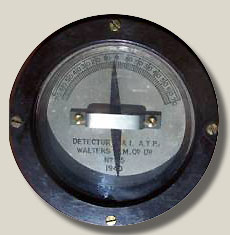 |
A vintage galvanometer, maybe which makes a fine Loomis detector (Physics Museum) |
Like so many others, he was ahead of his time. He antedated the work of Marconi by at least twenty years, and was ahead of Alexander Popov, the Russian inventor, by nearly thirty years. Unless further historical research turns up someone else who has a prior claim, Mahlon Loomis deserves to be recognized as the real "Father of the Radio.". |